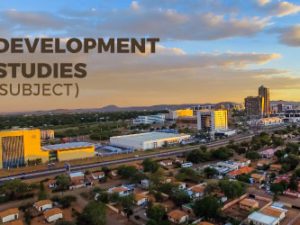- Description
- Curriculum
- Reviews
Senior Secondary Science is a two-year programme designed for learners who have completed Junior Secondary education. It is designed to provide learners with scientific knowledge, skills, and attitudes needed for understanding and responsible participation in society. It also prepares the learners for tertiary education, vocational training, and provides them with foundation skills for employment.
Subjects for the Senior Secondary programme are categorised into groups: core and optional. All the Science subjects fall into one optional group: Sciences. There are four forms of Science offered in the group and learners are expected to choose one. These are:
- Single Science;
- Double Science;
- Pure Sciences: Biology, Physics and Chemistry;
- Human Social Biology (only offered to private candidates)
The syllabuses have been developed on the assumption that each Science will be allocated 160 minutes per week.
Rationale
The Science Programme for the two years of senior secondary education is expected to facilitate the holistic development of the learner in a global context. The program intends to instill a sense of appreciation for science and to make sure that the learners can cope in a technologically changing world. The program will help learners to explore and apply the scientific knowledge, skills and attitudes acquired to address environmental, social, economic, and political issues in their day-to-day lives. Through this program, learners will get an opportunity to explore and understand the natural world (life processes, physical phenomena, and the nature of substances).
Science is an experimental discipline and its method of inquiry allows learners to appreciate the practical impact of science on their lives and society as a whole. The Science program will equip learners with skills that will be of long term value and encourage them to participate in lifelong learning. In the process the learners will exercise their creativity and develop skills such as critical thinking, innovativeness, communication, analysis, observation, recording, drawing conclusions, making judgements, etc.
The syllabuses will also expose learners to the practical applications of Science. This will contribute towards popularising Science and developing an interest in and positive attitudes towards Science among all learners.
The Senior Secondary Science syllabuses recognise the importance of offering key concepts and principles of Science in Physics, Chemistry, and Biology to provide learners with a more unified view of the Sciences and awareness of the connections among them and technology.
Aims of Senior Secondary Programme
On completion of the two-year secondary programme, learners should have: –
- acquired knowledge developed confidence and ability to assess their personal strengths and weaknesses and be realistic in choosing appropriate career/employment opportunities and/or further education and training.
- developed skills to assist them in solving technical and technological problems as they relate to day-to-day life situations.
developed desirable attitudes and behavioral patterns in interacting with the environment in a manner that is protective, preserving, and nurturing.
- acquired attitudes and values developed basic skills and understanding to allow for the execution of rights and responsibilities as good citizens of Botswana and the world.
- developed information technology skills as well as an understanding and appreciation of their influence in day-to-day activities.
- acquired knowledge, attitudes, and practices that will ensure good family and health practices, including awareness and management of epidemics (such as HIV/AIDS), that prepare them for a productive life.
- developed pre-vocational knowledge and manipulative skills that will enable them to apply content learned and attitudes and values developed to practical life situations in the world of work.
- developed an understanding of and acquired basic skills in business, everyday commercial transactions, and entrepreneurship.
- developed foundation skills such as problem-solving, critical thinking, communication, inquiring, teamwork / interpersonal to help them to be productive and adaptive to survive in a changing environment.
Organisation of the syllabus
The syllabus is organized around broad content areas subdivided into topics. Each topic consists of general objectives which give rise to specific objectives. The specific objectives describe what learners are expected to do. These objectives are divided into core and extended. The extended specific objectives are highlighted in bold italics. All learners are expected to follow the core-specific objectives. The extended objectives provide more challenging work for those learners able to benefit from it.
-
6Electric CurrentText lesson
-
7Potential DifferenceText lesson
-
8ResistanceText lesson
-
9Conventional Current & Electron FlowText lesson
-
10Circuit SymbolsText lesson
-
11Ohm’s LawText lesson
-
12Using the equation V=IxRText lesson
-
13Potential Difference GraphsText lesson
-
14DiodesText lesson
-
15Light-Dependent Resistors (LDRs)Text lesson
-
16ThermistorsText lesson
-
51What are Forces?Text lesson
-
52Newton's First Law of MotionText lesson
-
53Newton's Second Law of MotionText lesson
-
54Newton's Third Law of MotionText lesson
-
55MomentumText lesson
-
56FrictionText lesson
-
57Stopping DistanceText lesson
-
58Air ResistanceText lesson
-
59Terminal VelocityText lesson
-
63Basic Wave TheoryText lesson
-
64Transverse WavesText lesson
-
65Longitudinal WavesText lesson
-
66Frequency of wavesText lesson
-
67The Wave EquationText lesson
-
68ReflectionText lesson
-
69RefractionText lesson
-
70Convex & Concave LensesText lesson
-
71Use of lenses for correcting visionText lesson
-
72Refractive IndexText lesson
-
73Total Internal ReflectionText lesson
-
74Optical FibresText lesson
-
75DiffractionText lesson
-
76Interference of WavesText lesson
-
77Interference of LightText lesson
-
78Sound WavesText lesson
-
79Pitch, Loudness and Quality of Musical NotesText lesson
-
80UltrasoundText lesson
-
81Uses of UltrasoundText lesson
-
92WorkText lesson
-
93Forms of EnergyText lesson
-
94Kinetic EnergyText lesson
-
95Potential EnergyText lesson
-
96Electrical EnergyText lesson
-
97Conservation of EnergyText lesson
-
98Energy Transfer Diagrams and EfficiencyText lesson
-
99Heat TransferText lesson
-
100ConductionText lesson
-
101ConvectionText lesson
-
102RadiationText lesson
-
103The EarthText lesson
-
104Igneous RocksText lesson
-
105Metamorphic RocksText lesson
-
106WeatheringText lesson
-
107Erosion & TransportText lesson
-
108The Rock CycleText lesson
-
109Wegener and Continental driftText lesson
-
110Plate TectonicsText lesson
-
111Convection CellsText lesson
-
112Tectonic Plate MotionText lesson
-
113Convergent BoundariesText lesson
-
114Divergent BoundariesText lesson
-
115Transform BoundariesText lesson
-
116The Solar SystemText lesson
-
117The Solar System animationText lesson
-
118Gravitational Force, Centripetal Force & OrbitsText lesson
-
119The SunText lesson
-
120Solar EclipseText lesson
-
121Lunar EclipseText lesson
-
122CometsText lesson
-
123AsteroidsText lesson
-
124Life cycle of StarsText lesson
-
125Death of Low Mass Stars - White & Black DwarfsText lesson
-
126Death of High Mass Stars - Neutron Stars & PulsarsText lesson
-
127Death of Very High Mass Stars - Black HolesText lesson
-
128Earth Based Telescopes – Optical TelescopesText lesson
-
129Earth Based Telescopes – Radio TelescopesText lesson
-
130Space based TelescopesText lesson
-
131The Expanding UniverseText lesson
-
132Doppler EffectText lesson
-
133Red ShiftText lesson
-
134What is Radioactivity?Text lesson
-
135IsotopesText lesson
-
136Stable and Unstable NucleiText lesson
-
137Alpha, Beta and Gamma RaysText lesson
-
138Penetrating Properties of RadiationText lesson
-
139Properties of Radiation – Deflection in an electric fieldText lesson
-
140Properties of Radiation – Deflection in a magnetic fieldText lesson
-
141Detecting radioactivity – the Geiger Muller TubeText lesson
-
142Radioactive Half LifeText lesson
-
143Uses of RadioactivityText lesson
-
144Radiation in the treatment of cancerText lesson
-
145Alpha particles in smoke detectorsText lesson
-
146Beta radiation in thickness controlText lesson
-
147Beta radiation in leak detectionText lesson
-
148Gamma rays in sterilisationText lesson
-
149Radiocarbon datingText lesson
-
150What is nuclear fission?Text lesson
-
151Chain reactionText lesson
-
152A nuclear reactorText lesson
-
153A nuclear power stationText lesson
-
154Radioactive wasteText lesson
-
155What is nuclear fusion?Text lesson
-
156Background radiationText lesson
-
157Absolute zero and the Kelvin scale of temperatureText lesson
-
158Pressure and volume relationship of a gas – Boyle's lawText lesson
-
159Volume and temperature relationship of a gas – Charles' lawText lesson
-
160Pressure and temperature relationship of a gas – the Pressure LawText lesson
-
161The gas equationText lesson

Popular Subjects
Working hours
| Monday | 9:30 am - 6.00 pm |
| Tuesday | 9:30 am - 6.00 pm |
| Wednesday | 9:30 am - 6.00 pm |
| Thursday | 9:30 am - 6.00 pm |
| Friday | 9:30 am - 5.00 pm |
| Saturday | Closed |
| Sunday | Closed |
About
The Most Secure & Collaborative Learning Platform.
Classmate is an Inclusive, Social E-Learning platform, for students and educators to access educational content and promote collaborative learning.
The solution has been developed after making an assessment that there is a need for students to interact outside the classroom yet enjoying the classroom set up with the additional freedom of engagement
Popular Subjects









